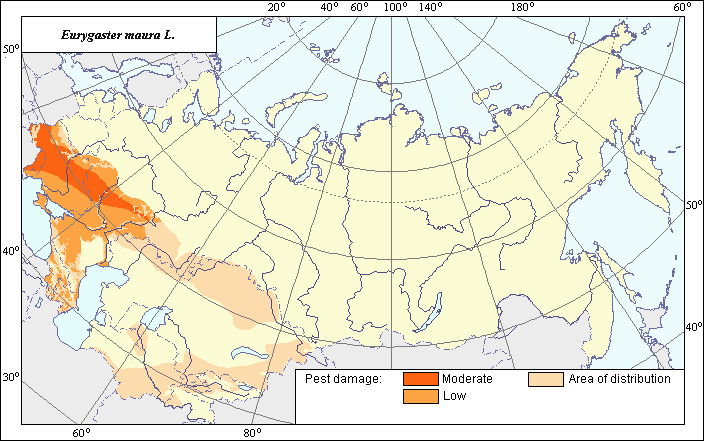Pests
Area of distribution and damage of Eurygaster maura Linnaeus
 Object description Download GIS-layers
Object description Download GIS-layers
Authors:
Specialist-biologist M.N. Berim,GIS-specialist M.I. Saulich.
Date of creation:
05.06.2006.Scale:
1:20 000 000.Accuracy of map:
It is created on materials of map of natural scale 1:33 000 000.Projection:
"Alber's Equal Area Conic", 9, 1001, 7, 100, 0, 44, 68, 0, 0.Basic contents:
Vector map is composed of 3 thematic layers. Zones of distribution and damage are shown by polygons.Accuracy of the classifier:
The insect area is divided into zones of moderate and low damage using the published materials (Sokolova, 1901; Taranukha, 1952, 1954). The zone of moderate damage includes regions that are characterized by average population density 5 and more bugs per 1 sq. m; the zone of low damage has 1 to 5 bugs per 1 sq. m.Method of map production:
The northern border has been marked after the published materials (Kosov & Polyakov, 1958), the materials of VIZR expeditions have been also taken into account. The results of the analysis of hosts spreading have been used according to the Atlas of the USSR vegetation, taking into account the temperature preference of this insect. The species is observed northward to Byelorussia, Smolensk, Moscow, Nizhnii Novgorod, Ryazan' Regions, Tatarstan. The bug does not appear in Siberia and Primorskii Territory (Puchkov, 1972). Authors include the Transcaucasia, Middle Asia, and Kazakhstan into the pest area, but this species occurs there in small number, in mountains only. High mountains and deserts are excluded from area. The borders of zones of different damage are given using criteria that have been published by N.N. Sokolova (1901); M.D. Taranukha (1952, 1954); I.M. Kerzhner & T.L. Yachevskii (1964); V.P. Vasil'ev (1973); A.A. Migulin (1983). The insect has low fecundity, observing late awakening, so it is not very dangerous. It usually feeds on grasses. Sometimes, during droughty years, the pest appears on crops. Moderate damage appears usually in southern part of forest zone and in forest-steppe zone (Puchkov, 1972; Vasil'ev,1973). The vector map of the distribution of cereals within the territory of the Former Soviet Union have been used for the correction of damage zones (Koroleva et al., 2003). The map has been scanned; its registration and vectorization have been made by GIS-technology means.Reference of citations:
Baranov A.N. 1969. Atlas of the USSR. Moscow: Chief Department of Geodesy and Cartography. P. 90-91 (in Russian).Kerzhner I.M. & Yachevskii T.L. 1964. Order Hemiptera - bugs. In: Bei-Bienko G.Ya., ed. Keys to insects of the European part of the USSR. V. 1. Moscow & Leningrad: Nauka. P. 830 (in Russian).
Kosov V.V. & Polyakov I.Ya. 1958. Forecasting and calculation of pests and diseases on agricultural cultures. Moscow: Agricultural Department. P. 250-251 (in Russian).
Migulin A.A., ed. 1983. Agricultural entomology. Moscow: Kolos. P. 77 (in Russian).
Puchkov V.G. 1972. Order Hemiptera - bugs. In: Kryzhanovskii O.L., ed. Insects and mites- pests of agricultural cultures. V. 1. Leningrad: Nauka. P. 227 (in Russian).
Sokolova N.N. 1901. Sunn pest. In: Insects and others animals - pests of agricultural crops. V. 3. St.Petersburg: Marks. 84 p. (in Russian).
Taranukha M.D. 1952. Cereal bugs in forests and forest strips. In: Pogrebnyak P.S., ed. Proceedings of Academy of Sciences of UkrSSR, N 4. Kiev: AN UkrSSR. P. 67-79 (in Russian).
Taranukha M.D. 1954. To ecology of cereal bugs of the genus Eurygaster. In: Markevich A. P., ed. Proceedings of Kiev State University. Kiev: State University. Part 1. P. 260-261 (in Russian).
Vasil.ev V.P., ed. 1973. Pests of agricultural crops and forest plantations. Vol. 1. Kiev: Urozhai. p.348-350 (in Russian).
Right and copyright:
All rights reserved. Copyright 2006 © M.N.Berim & M.I.Saulich (vector map, description)Photo © V.Neymorovets (VIZR)

